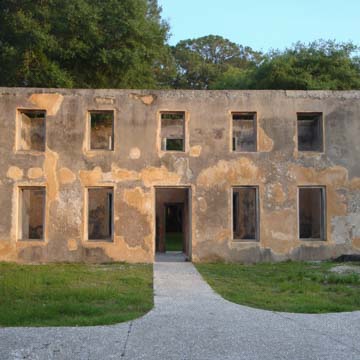Jekyll Island’s first colonist was William Horton, who, at age twenty, established a plantation on the barrier island in the early eighteenth century, furnishing grain and hops for Georgia’s first brewery. At the time, the island was known by its native Guale tribe as Ospo. Horton, who was second in command in General James Oglethorpe’s regiment, had arrived in Georgia in 1733 to establish an English colony. With a labor force of indentured servants, Horton cleared the land, built a sand road across the island (still in use today), erected a barn, and constructed a plantation house out of tabby, a primitive concrete. The tabby was made of burnt oyster shells (lime) mixed with water, sand, and crushed oyster shells. It was then set into formwork until it hardened, creating walls.
The actions of Oglethorpe and Horton incurred the wrath of the Spanish, who claimed the area for their own. A few years after the War of Jenkins’s Ear (1739–1748) broke out, the Spanish moved north from St. Augustine to try to oust the English. Although defeated on St. Simon’s Island at the Battle of Bloody Marsh, the Spaniards raided Jekyll Island as well and burned Horton’s new house, barn, and other outbuildings in 1742. The two-story house was rebuilt the following year.
After the American Revolution, the DuBignon family moved into the Horton House and continued to operate the Horton plantation. They were a family of French royalists who immigrated to America in order to escape the violence of the French Revolution. Their family cemetery is across the road from the Horton House, which they occupied until the mid-1800s. DuBignon harvested long staple “Sea Island” cotton, and his descendant, John Eugene DuBignon, was the founder of the Jekyll Island Club.
Horton House remains one of the earliest surviving structures in the state, although it is today merely a tabby ruin due to subsequent deterioration. Its preservation is more substantial than the tabby ruins of Horton’s brewery nearby.
References
McCash, June Hall. The Jekyll Island Cottage Colony. Athens: University of Georgia Press, 1998.














